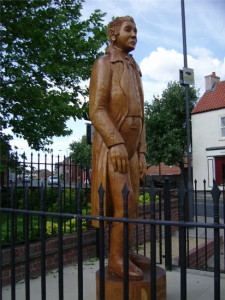William Bradley – The Yorkshire Giant
William Bradley, the Yorkshire Giant, was born at Market Weighton in the East Riding of Yorkshire on the 10th February 1787. He was the fourth son of a family of thirteen, who were all of normal build.
At the age of 20 he was an amazing seven feet and nine inches tall (2.36M), and weighed 27 stones (171.46 kg). He died on the 30th May 1820. He spent some years as the ‘Yorkshire Giant’ with a group of travelling showmen, before eventually retiring to his native Market Weighton.
After his death he was buried in the grounds of All Saints Church, but as it was feared that body snatchers might attempt to steal his remains, he was later re-interred inside the church itself.
William Bradley is an essential part of Market Weighton’s history, and his life has been commemorated each year. William Bradley’s house is in York Road, Market Weighton. The house was constructed for him, with rooms and doorways large enough to accommodate his exceptional build.
Each year Market Weighton celebrates the life of William Bradley by holding a ‘Giant Bradley Day’. The first event took place in May 1996, and was originally called Bradley Day. During these celebrations the main street through the town is closed to traffic so that residents and the many visitors to the town can enjoy the various stalls, exhibitions, entertainers, etc. This is a wonderful day for everyone, especially children, and should not be missed. Please see our Events page for further details of this event.
Rifle Butts Quarry Nature Reserve
This is situated 1 mile from Market Weighton just off the Hudson Way up the minor road towards Goodmanham. The particular interest of this reserve is the geological feature exposed on the quarry face. The exposure, of national importance, shows a Cretaceous unconformity, where sediments from the Jurassic and Lower Cretaceous periods were eroded away!
In the late Cretaceous period the sea once again covered the area depositing red and then white chalk. The cretaceous sea was inhabited by huge sharks and ichthyosaurs not the place to go for a swim.
Yorkshire Wildlife Trust acquired both Rifle Butts and Kiplingcotes quarries in 1964.
Prior to this the quarry was used as a Rifle Range up until the Second World War. The old target marker pit has been filled in with topsoil and as a result comfrey, giant bellflower, sweet cicley and leopards-bane were introduced to the reserve. Snowdrops, winter aconites and bluebells are present in spring and were probably planted. The quarry was probably dug to provide chalk for the building of the railway embankment opposite the reserve.
Over 150 plants have been recorded from the reserve even though it is only an acre in size. Characteristic chalk species include wild marjoram, wild basil, great knapweed, common knapweed, toadflax, agrimony, common spotted orchid and pyramidal orchid. Breeding birds include willow warbler and yellowhammer aswell as many common garden birds. The reserve is important for butterflies ringlet, meadow brown, common blue and marbled white can all be seen here. In 2008 a new species has been recorded brown argus which is expanding its range northwards.
The reserve is managed by young people from the local Wildlife Watch Groups with help from a few adults. This involves cutting the grassland and raking off the hay, you will see piles of grass rotting in corners of the reserve and removing invasive elder and hawthorn.
Hudson Way Wildlife
During the winter the Hudson Way becomes a magnet for thrushes arriving from Scandinavia who come to feast on the haws. Look out for redwing, fieldfare, song thrush and blackbird. In hard winters waxwings are forced to migrate from continental Europe in search of fruit.
This time of year is a good time to see larger birds of prey. Buzzard and red kite are returning to the Yorkshire Wolds to breed and are being very successful. Red kite are very distinctive with their forked tail which they use as a rudder.
They are scavengers feeding on road kill, following ploughing tractors to eat leatherjackets, worms and beetles and taking the occasional rabbit. Kites in the winter roost together and there is a roost site close to the village of Nunburnholme over 20 kites sometimes can be seen here. Buzzard have rounder wings and are often seen soaring over the woodland, they mostly feed on rabbits. The steep scarp slope of the escarpment of The Wolds produces thermals and updrafts which lets these bird soar with very little effort.
In Market Weighton the beck is an important habitat for one of our most endangered species of mammal. Water voles (ratty from wind in the willows) can still be seen on both sections of the beck. Look out for their holes, lawns and latrines to show they are at home, they don’t hibernate so you are more likely to see one in the winter. Often the only give away sound will be a plop as they dive into the stream to get away from predators. Water vole numbers are down 93% in the last 20 years, this is mostly due to the release and escape of American mink from fur farms in the 1980’s. Thankfully mink haven’t been seen in Market Weighton. However there are signs of otters returning to the River Foulness and Market Weighton canal catchment. The stream in Market Weighton which springs from the chalk at Springwell’s close to Rifle Butts Quarry is very clean and supports a large range of invertebrates including freshwater shrimp, caddis fly larvae (they make their own homes from stones and grass), mayfly larvae and stonefly larvae. Bullhead fish are common.
Yorkshire Wildlife Trust Website: www.wildlifetrusts.org


